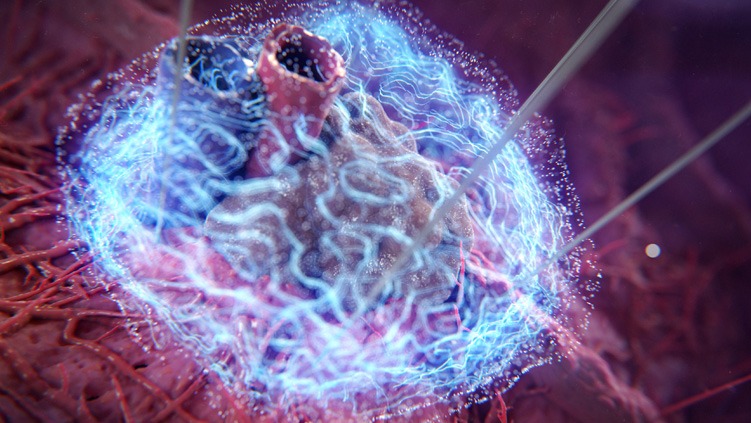NanoKnife IRE
A New Approach to Localized Therapy
For more information or to schedule a patient consultation, call 630-UROLOGY or visit https://uropartners.com/contact.
Nanoknife, also known as irreversible electroporation (IRE), is a minimally invasive treatment option for prostate cancer. It uses electrical pulses to destroy cancer cells. It may be considered for localized prostate cancer in certain cases, but it's important to discuss treatment options with a healthcare professional to determine the best approach for your specific situation, as treatments can vary depending on the stage and characteristics of the cancer.
Minimally Invasive Treatment for Focal Tumors
NanoKnife, also known as irreversible electroporation (IRE), is a minimally invasive medical procedure used to treat certain types of prostate cancer. Here are some details about NanoKnife for prostate cancer:

Principle of NanoKnife
NanoKnife uses electrical pulses to create small, permanent nanopores in the cell membranes of cancerous tissue. This disrupts the cancer cells’ ability to function and causes them to die off.
Minimally Invasive
NanoKnife is a minimally invasive procedure, which means it doesn’t require large surgical incisions. Instead, it is typically performed using thin, needle-like electrodes inserted through the skin into the prostate gland.
Targeted Treatment
NanoKnife allows for precise targeting of cancerous tissue while sparing nearby healthy tissue and critical structures like nerves and blood vessels. This precision is particularly important in the treatment of prostate cancer, as preserving erectile function and urinary continence is a priority.
Benefits
Some of the benefits of NanoKnife for prostate cancer include reduced side effects compared to traditional treatments like surgery or radiation therapy. It can be an option for patients who may not be candidates for other treatments due to their health or the stage of their cancer.
Procedure
During the procedure, ultrasound imaging is used to guide the placement of the electrodes. Electrical pulses are then delivered to the targeted areas to destroy the cancer cells.
Recovery
Recovery time for NanoKnife is typically shorter compared to surgery. Patients may experience some discomfort, but it is generally well-tolerated.
Effectiveness
The effectiveness of NanoKnife for prostate cancer can vary depending on the patient’s specific case. It is often used for localized prostate cancer that has not spread to other parts of the body.

Who Is a Candidate for IRE Treatment?
IRE is an effective treatment option for prostate focal therapy, or for salvage therapy when radiation fails. A consultation with our experts at UroPartners can help you determine if this treatment is appropriate for you.
What to Expect With IRE
Before undergoing IRE, you will be scheduled to have imaging studies done, usually an MRI with and without contrast. This allows our experts to evaluate the exact size and location of the tumor and plan the ideal placement of the IRE probes.
You will be asked to return for an appointment approximately two weeks before your IRE procedure to have a pre-procedure work up completed. This visit includes a complete medical history and physical examination. Any necessary lab tests will also be done at this time.
On the day of your procedure, our doctors will do an ultrasound to guide the placement of the four probes that will send the electrical energy to the tumor.
The actual IRE procedure lasts less than an hour and patients are typically able to go home the same day.
Approximately one month after the procedure, you will be asked to return for follow-up imaging to evaluate the treated area as well as to continue surveillance of the rest of the prostate.
NanoKnife® procedure
UroPartners has some of the only physicians to offer NanoKnife®, another option used to treat certain patients with advanced pancreatic, liver and soft tissue cancers. The list of our physicians who offer NanoKnife® are:
The NanoKnife® system offers a less invasive treatment option for patients with smaller focal tumors or salvage after radiation failure. NanoKnife® is typically one part of a patient's treatment, along with observation or active surveillance.
What are the advantages of NanoKnife®?
Since the electrical pulses are contained, the NanoKnife® system helps to minimize damage to surrounding healthy cell tissue and other important structures, resulting in few to no side effects. It is done as an outpatient procedure and it may help to preserve sexual function and continence, especially as compared to conventional surgery or radiation therapy. It may also be used as salvage treatments when others fail.
Who is eligible for NanoKnife®?
Not all patients meet the criteria for the NanoKnife® procedure. It may be an option if you are on active surveillance or have failed radiation therapy and need a salvage procedure.
You, your surgical oncologist, and the rest of your care team will determine if NanoKnife® is appropriate for you.
What are the next steps?
For more information or to schedule a patient consultation, call 630-UROLOGY or visit https://uropartners.com/contact.






